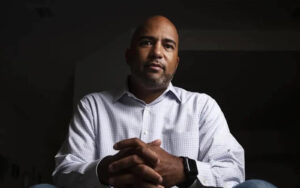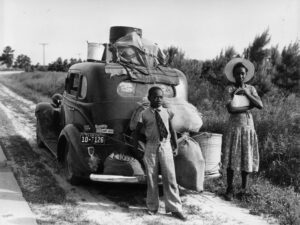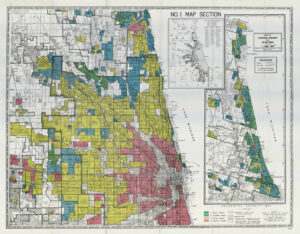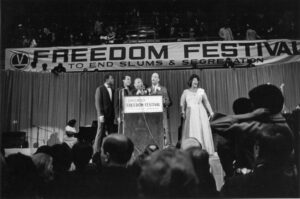
It’s as if James Baldwin was talking to me from 1963 when he stated, “It will be hard, James, but you come from sturdy, peasant stock, men who picked cotton and dammed rivers and built railroads, and, in the teeth of the most terrifying odds, achieved an unassailable and monumental dignity.” (The Fire Next Time)
And here I stand!
Stand Up. Speak Out.
When I see something that is nefarious trying to rear its head, I feel a responsibility to speak out. I don’t speak out for self-preservation. Honestly, if that were the goal I’d likely just keep my mouth shut, as so many choose to do. I speak out because I see something that is tearing away at the fabric of our society, pitting us against each other as enemies, appealing to the deepest fears in our souls. When I see it, I call it. I stand by it, firmly. There is too much at stake.
And I refuse to sit idly by and allow my fellow man to suffer under the weight of bigotry, hate, and intolerance. Silence serves no one. Not even yourself because, as history has shown, while it may not be you they’re after in the moment…they’re coming, just you wait. No, silence is complicity to whatever is seeking to plague our society.
And Then They Came For You…
I’ve done my due best to speak up and sound the alarm about what is going on in our local communities surrounding schools. Some chose to ignore those cries and believe that there was some world where this small group of hateful, intolerant, Facebook Echo-Chamber Warriors were just after me. Once I was a distant memory, all would be well in the land, and they could go on about their beautiful lives.
But it was never about me. And that is, precisely, what I told every news outlet I spoke to for the better part of the last two years. I’d be a fool to believe this was all about me. Many were fools that ended up believing that tale. No, my story is no isolated ordeal. Nor is it new to our communities. This is historical.
But far too many people fail to embrace history in such a way. They’re blindsided when the dog whistles of “parental rights” and “protect our students” crops up. Then, by the time they realize that this turns out to be the same old manufactured panic we’ve dealt with over the course of our nation’s history, the bill is due. The nonsense has landed, squarely, at their door and they look around, baffled that this could ever happen to them.
I’ve been trying to tell you. Do you hear me know? Is it clear to you?
They are after the whole thing!
The Guardians of Our Society, Educators
I’ve had the opportunity to speak to thousands of educators over the course of my time in public education. Every chance I get, I tell them my story and how, had it not been for a handful of educators, I know that my life would be drastically different. They rescued me from a very dark place.
I share that with them to emphasize that there are students like me in their classrooms every day. Some facing greater challenges, others fewer. Yet, their responsibility is to educate them all as they come to them. It’s not an effortless task.
They bear the weight of addressing so many of society’s ills in addition to the content they teach. Nevertheless, they tackle it with a smile and unwavering determination. They are truly the guardians of our society.
And that’s what’s at stake – our society. We have folks with nefarious agendas pumping millions of dollars into a machine that seeks to destroy public schools as we know it. I know you’ve heard the rallying cries. But it ain’t all what it seems. So I want you to be informed. And I want you to reach out to your legislators as we head into this crazy special session to let them know that you won’t stand for the lies.
Deep in The Heart of Texas
In Article 7, Sec. 1. SUPPORT AND MAINTENANCE OF SYSTEM OF PUBLIC FREE SCHOOLS in the Texas Constitution it states
A general diffusion of knowledge being essential to the preservation of the liberties and rights of the people, it shall be the duty of the Legislature of the State to establish and make suitable provision for the support and maintenance of an efficient system of public free schools.
That doesn’t say it could be. It doesn’t say it should be. It says it SHALL be the duty of the Legislature of the State to establish and make suitable provision for the support and maintenance of an efficient system of public free schools.
Support and maintenance of an efficient system of public and free schools could look like a few things:
- Fully funding special education so students with specific needs aren’t left behind.
- Increasing teacher pay so teachers aren’t forced to work two and three jobs just to make ends meet.
- Increasing the basic allotment (which has not been increased since 2019)
- Ending the reliance on outdated standardized measures of assessment that don’t take into account meaningful, relevant learning experiences and 21st century skills our students need and various industries desire.
- A meaningful cost of living increase for our retired educators.
- Keeping public dollars in public schools.
Texas currently stands at 43rd place in terms of per-student funding and our educators are facing a significant pay gap of $7,500 compared to the national average. Addressing these disparities in teacher compensation and providing attractive incentives for new educators should unquestionably top our list of priorities.
However, regrettably, our governor has called a special session to convene with one of the aims being to advance the controversial concept of vouchers. This shift in focus is concerning because vouchers have the potential to exacerbate our education challenges rather than alleviate them. By diverting resources away from our public schools, they could usher in larger class sizes, a further decline in teacher salaries, and ultimately, detrimental outcomes for the students of Texas.
How Did We Get Here?
In case you’ve been sleeping up till now, let me introduce you to Tim Dunn and Farris Wilks, a billionaire duo out of West Texas. These two aren’t just your average rich folks who just like fancy toys; they’re the architects of a stunning political narrative that’s shaping the Lone Star State in ways that could soon leave it unrecognizable.
These billionaires have a plan in motion that involves a not-so-secret scheme in the world of education – a private school voucher system. But, their ambitions don’t stop there. What they’re really aiming for is a monumental transformation of Texas itself, steering it towards an authoritarian, Christian Nationalist state.
Two billionaire-pastors with an abundance of riches are pouring their fortunes into making their extreme Christian nationalist worldview a reality. In the second-largest state in the U.S., no less. Before I go further, let me remind you – I am a Christian. But I ain’t this. The Christian nationalist worldview is something out of a dystopian novel – think Handmaid’s Tale. I don’t say this, jokingly. I’m dead serious. It continues to shock me that this incredible story flies under the radar. But we better start paying attention.
Their financial influence is otherworldly. With over $100 million in contributions, they’ve effectively bought their way into the hearts and minds of Texas politicians. And it’s not just politicians; they’ve also created a vast web of PACs, think tanks, and media outlets that dance to their tune. Every extremist policy coming out of Texas recently? Well, it seems to trace back to these two.
When they’re not busy bankrolling politics, Dunn and Wilks take to their pulpits, where they preach a theology of power, control, and domination, rather than the universal love typically associated with Christianity. Alarming as that may be, their radical beliefs are translating into Texas law.
Their reach is staggering. Nearly every Republican State Senator and over half of Republican House members in Texas have accepted their money. For some, a whopping half of their campaign contributions stem from these two billionaires. Even the highest-ranking officials in Texas have their pockets lined by Dunn and Wilks.
Out of one side of their mouths they’re claiming that teachers are indoctrinating students and the other they’re bankrolling PragerU, a right-wing “education” platform, they’re determined to push in to shape the very curriculum in our schools. Talk about irony. We exist to help young people develop critical thinking skills, amongst other valuable 21st century skills. They LITERALLY want to indoctrinate young people to believe as they do, or else. You can’t make this stuff up. Always remember, their accusations are, quite often, admissions.
But here’s where it gets downright audacious: they’re embarking on their most ambitious endeavor yet—replacing public schools with Christian ones. Governor Abbott has even called a special session to push through their voucher scheme. The playbook has been front and center from the beginning. Many of us have tried to sound the alarm so many times, but here goes again.
They seek to sow mistrust by fueling controversies to discredit public schools. And in the midst of the confusion and fear they will pass private school vouchers to defund them. Then, in the end, close public schools entirely, shifting the entire system to private, Christian nationalist education.
Call to Action
I love my home state of Texas. We’re above this. We are too monumental to be sold to the highest bidder. Fear, hate, intolerance, and bigotry cannot rule the day. We may still have a ways to go, but we’ve come so far. In the end, school vouchers – ESA’s, whatever they want to call them – in Texas undermines our Constitution and our commitment to providing equitable and quality education for all of our students.
I hope you’ll join me in reaching out to your legislator and letting them know, LOUD and CLEAR, that we want public dollars to stay in public schools. Let them know they’ve insulted our intelligence for far too long. And we refuse to be sold to the highest bidder.
SAY NO TO SCHOOL VOUCHERS!!!



